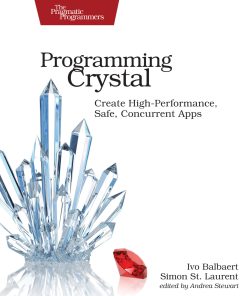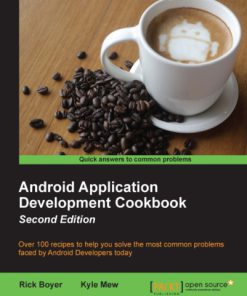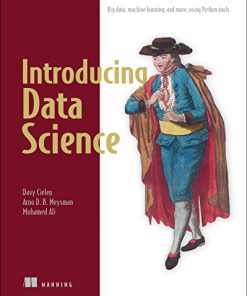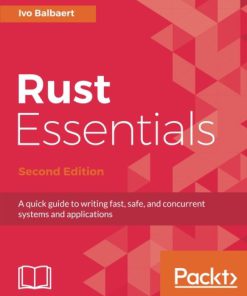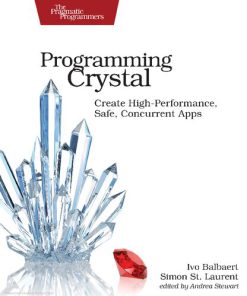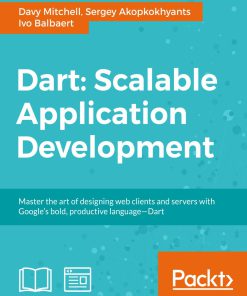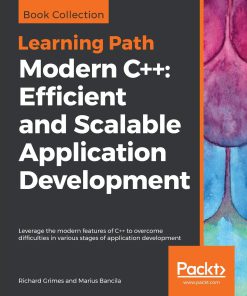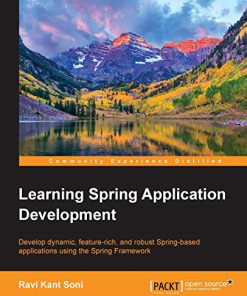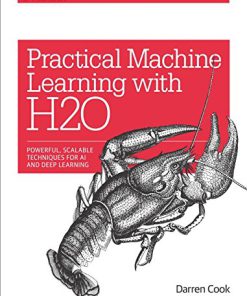Dart Scalable Application Development Learning Path 1st Edition by Davy Mitchell, Sergey Akopkokhyants, Ivo Balbaert 1787289116 9781787289116
$50.00 Original price was: $50.00.$25.00Current price is: $25.00.
Dart Scalable Application Development Learning Path 1st Edition by Davy Mitchell, Sergey Akopkokhyants, Ivo Balbaert – Ebook PDF Instant Download/DeliveryISBN: 1787289116, 9781787289116
Full download Dart Scalable Application Development Learning Path 1st Edition after payment.

Product details:
ISBN-10 : 1787289116
ISBN-13 : 9781787289116
Author: Davy Mitchell, Sergey Akopkokhyants, Ivo Balbaert
Master the art of designing web client and server with Google’s bold and productive language – Dart About This Book • Create robust applications with unit tests, documentation, and diagnostic logging • Master the core Dart language, type system, and key development tools • Connect to existing web services, process JSON, and create your own framework for the data display • Use mixins, reflections, annotations, and other metadata programming techniques to create powerful app Who This Book Is For If you are familiar with web development and are looking to learn, or even just evaluate, Dart as a multipurpose language, this learning path is for you. No familiarity with the Dart language is assumed. For beginners, it will serve as a guide to rapidly accelerate from a novice level to the master level; for intermediate to advanced developers it will quickly fill in the gaps on Dart and can explore a range of application types and powerful packages that are demonstrated in a practical manner. What You Will Learn • Handle form data and encryption • Set up your Dart environment to achieve the highest productivity • Run and debug the Dart server and web applications and compile them in JavaScript • Work with PostgreSQL—an industry standard relational database system • Create robust applications with unit tests, documentation, and diagnostic logging • Develop command-line applications, and explore the key data structures and libraries • Detect and use HTML5 features that will help you deliver rich, cross-platform content • Demonstrate the power of Polymer web components for binding data and structuring your web pages In Detail Designed to create next generation apps, Google’s Dart offers a much more robust framework and also supersedes JavaScript in several aspects. Familiar yet innovative, compact yet scalable, it blows away the accumulated JavaScript legacy limitations. Dart was designed for great tool-ability and developer productivity, allowing you to create better application faster than before. Google chose it for their billion dollar advertising business and you have its power for your projects too. The first module will introduce you the Dart language starting from its conception to its current form, and where it headed is through engaging substantial practical projects. You will be taken through building typical applications and exploring the exciting new technologies of HTML5. The second module will show you how to add internalization support to your web applications and how i18n and i10n access can be embedded into your code to design applications that can be localized easily. You will be shown how to organize client-to-server communication and how different HTML5 features can be used in Dart. Finally, this module will show you how you can store data locally, break the storage limit, and prevent security issues in your web application. The third module is a pragmatic guide that will increase your expertise in writing all kinds of applications, including web apps, scripts, and server-side apps. It provides rich insights on how to extend your Dart programming skills. Altogether, this course provides you the power to create powerful applications with Dart, without worrying about your knowledge leading to you having to make compromises to the end product! This Learning Path has been curated from three Packt products: • Dart By Example By Davy Mitchell • Mastering Dart By Sergey Akopkokhyants • Dart Cookbook By Ivo Balbaert Style and approach This is an enticing learning path that starts from the very basics to gradually pick up pace as the story unfolds. Each topic is explained with the help of recipes that solves a real-world problem involving hands-on work thus giving you a deep insight into the world of DART.
Subjects
Computers
Programming
Standard VitalSource Return Policy
Easy 14-day returns whenthese requirementsare met. View all policies.Opens in new window
Dart Scalable Application Development Learning Path 1st Table of contents:
1. Starting the Text Editor
Defining Dart
History of Web scripting
The origins of Dart
Downloading the tools
Introducing the WebStorm IDE
Alternative development environments
Help starting a project
Elsewhere in the SDK
Building your first application
Exploring the Web project structure
Unwrapping packages
A look at Pubspec
Putting Dart into the web page
Importing packages
Variable declarations
Writing the event handler
Loading the saved text
Saving the text
Running in the browser
Editing and reloading
Extending the interface
Using the CSS editor
Debugging a Dart application
Working in harmony with JavaScript
Commenting in the code
Summary
2. Advancing the Editor
The next steps for the text editor
Starting point
Dart classes
Structuring the project
Building the dialog package
The package project structure
Adding a local package reference
Understanding the package scope
Defining the base dialog box
The alert dialog box
The About dialog box
Using the confirmation dialog box
Counting words using a list
The Word Frequency feature
Understanding the typing of Dart code
The file download feature
The clock feature
Executing Dart code
Multi-processing the VM
The class designer
Building a more complicated dialog
Constructing the class
Understanding the flow of events
Launching the application
The command-line app for source code statistics
The command-line project structure
Processing the source code
File handling with the dart:io package
Debugging the command-line program
Integrating the statistics
HTML5 and the canvas
Drawing the pie chart
Building web interfaces with Dart
Compiling to JavaScript
Minification of JavaScript output
Summary
3. Slideshow Presentations
Building a presentation application
Laying out the application
Defining the presentation format
Parsing the presentation
A sample presentation
Presenter project structures
Launching the application
Building bullet point slides
Accessing private fields
Using true getters and setters
Mixin’ it up
Defining the core classes
Transforming data into HTML
Editing the presentation
Displaying the current slide
Navigating the presentation
Handling the button key presses
Using the Function type
Staying within the bounds
Using the slider control
Responding to keyboard events
Showing the key help
Listening twice to event streams
Changing the colors
Adding a date
Timing the presentation
Introducing the Stopwatch class
Implementing the presentation timer
An overview of slides
Handout notes
Comparing optional positional and named parameters
Summary
4. Language, Motion, and Sound
Going fullscreen
Request fullscreen
Updating the interface for fullscreen
Updating keyboard controls for fullscreen
Adding mouse controls
Adding metadata
Creating a custom annotation
Translating the user interface text
Exploring the intl package
Locating strings to translate
Extracting the strings
Running commands with Dart pub
Obtaining translations
Integrating the translations text
Changing the language of the user interface
Adding a language combo box
Working with dates
Formatting for the locale
Animating slides
Using a timer
Playing sound in the browser
Producing sound effects
Creating sound files
Loading sounds
Playing back sounds
Summary
5. A Blog Server
The Hello World server example
A blog server
Introducing the HTTP protocol
Starting up the server
Storing the blog posts format
Reading text files
Reading a folder of files
Request handling
Serving text
Robots.txt
Rendering a single blog post
Rendering the index page
Serving images
Locating the file
Serving a single image file
Serving a 404 error
Introducing Dart’s server frameworks
Redstone
Rikulo
Shelf
Deployment
Dependencies
Deploying on Unix
Using the screen command
Launching a screen
Deploying on Windows
Using the NSSM tool
Using a Microsoft solution
Load testing
Building a simple load tool
Summary
6. Blog Server Advanced
Logging
Writing text files
Extracting request information
A blog editor
Password protection
Encryption
Handling more complex forms
Processing the form
Saving data to a disk
Serving a default graphic
Refreshing the blog
Caching
Watching the filesystem
XML feed generation
Serving the RSS
The JSON feed generation
Serving the JSON
Consuming the JSON feed
Static generation
Freezing the website
Introducing the await and async keywords
Joining file paths
Creating an output folder
Generating the front page
Writing the static version
Load testing revisited
Updating the load tester
Summary
7. Live Data Collection
Kicking off the earthquake monitoring system
Introducing the data source
Exploring the GeoJSON format
Fetching and recording the data
Logging
A simple example of logging
Data monitor logging
Saving to the database
Installing a database system
Using PostgreSQL from Dart
Introducing the pgAdmin GUI
Creating the database and login
Defining the table
Inserting data
Running the program
Maintaining a database
Managing command line arguments
Retrieving data
Deleting data
Observing the Dart VM internals
Unit testing
Running unit tests
Writing unit tests for the data monitor
Grouping tests together
Examining the test results
Summary
8. Live Data and a Web Service
Freeing the data
Reworking the data collector
Adding a new data table
Filtering the data
Converting the feature to JSON
Improving the data maintenance
Storing the single feature
Running the data application
Creating the web service
Using the package rpc
Initiating the API server
Exposing methods
Error handling of incorrect requests
Serving the latest information
Supplying the data
Discovering the API
Running the web service
Recapping the system so far
Consuming application
Packaging the grid
Initiating the real-time updates
Performing the update
Fetching the JSON
Configuring the grid view control
Formatting the time
Working with date and time
Building the table
Showing the page
Summary
People also search for Dart Scalable Application Development Learning Path 1st:
dart application
dart development
dart web application framework
dart approach
learning dart and flutter
Tags: Dart Scalable, Application, Development Learning, Davy Mitchell, Sergey Akopkokhyants, Ivo Balbaert
You may also like…
Computers - Programming
Computers - Programming
Computers - Artificial Intelligence (AI)
Computers
Programming Crystal: Create High-Performance, Safe, Concurrent Apps 1st Edition Ivo Balbaert
Computers - Programming
Computers - Computer Science




